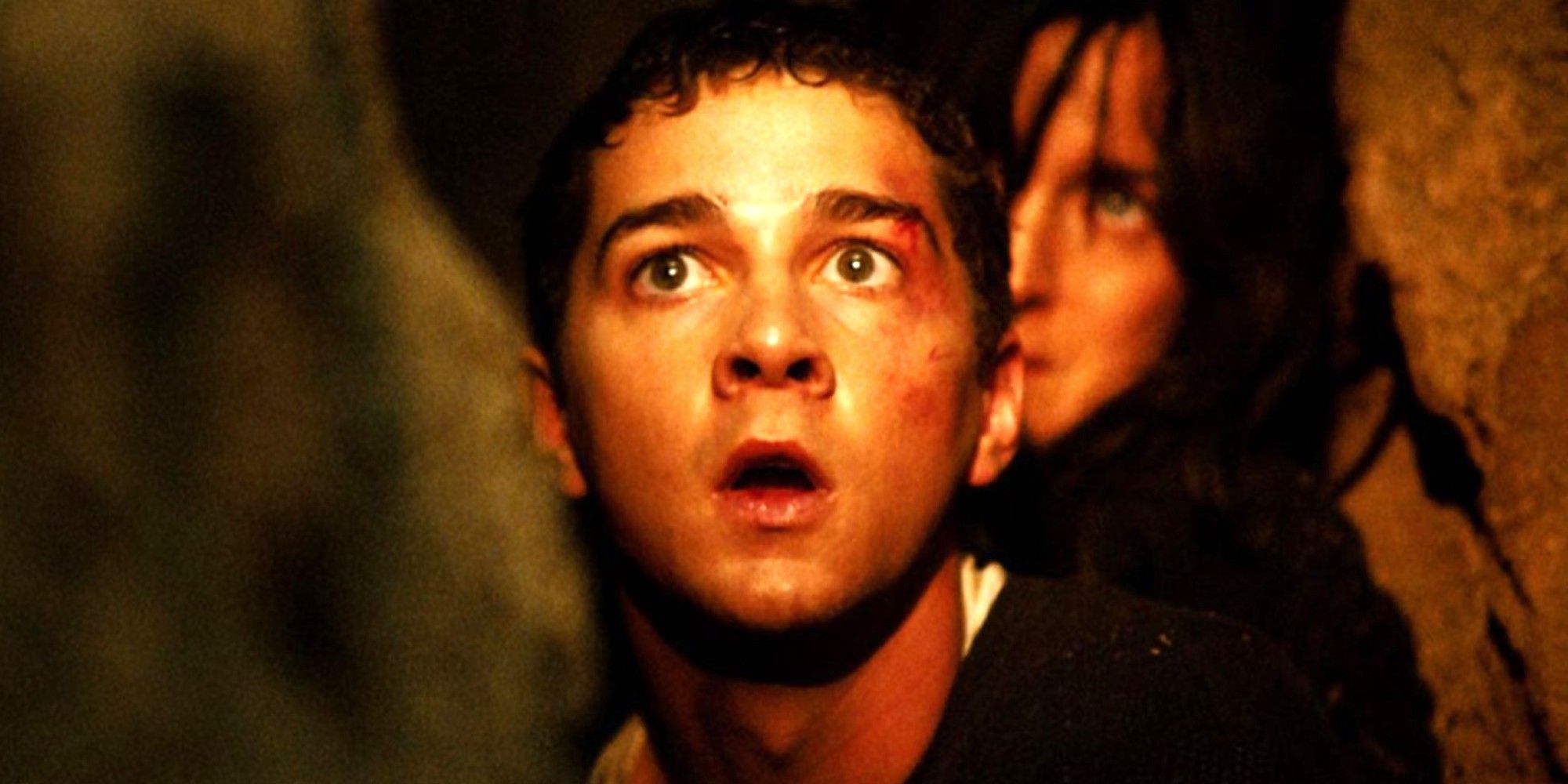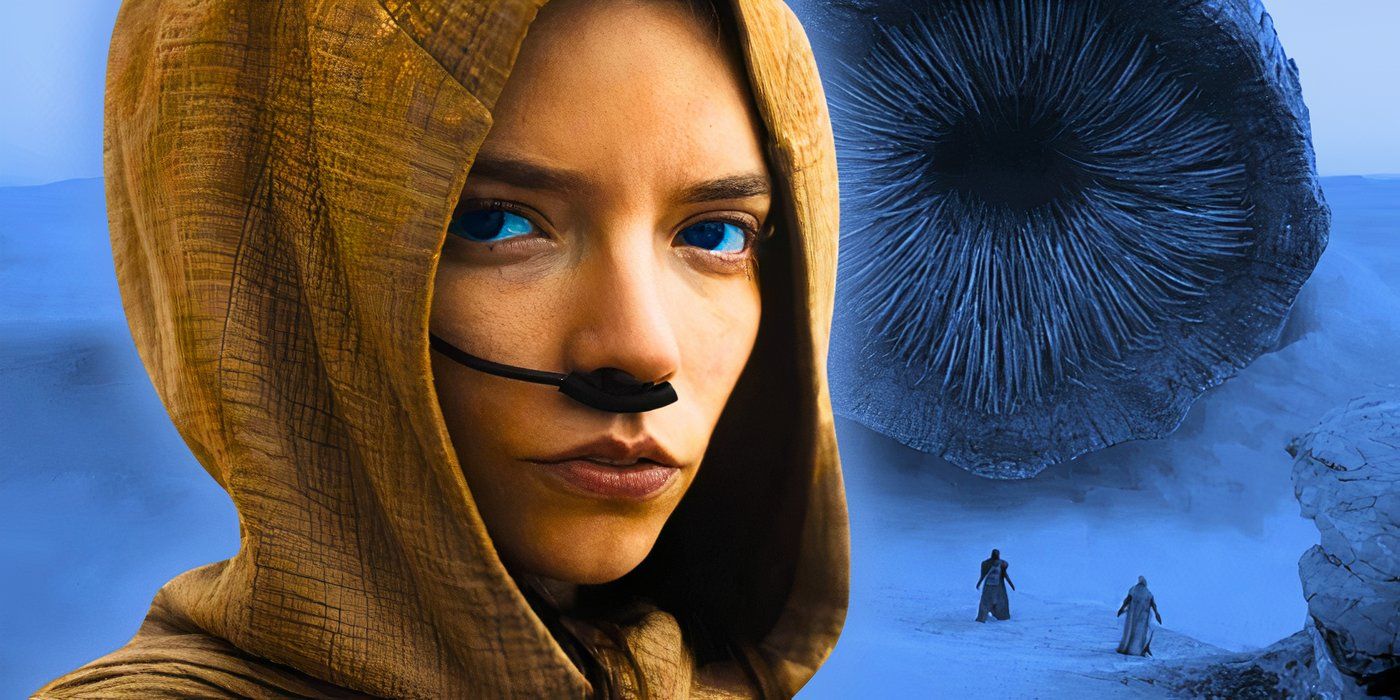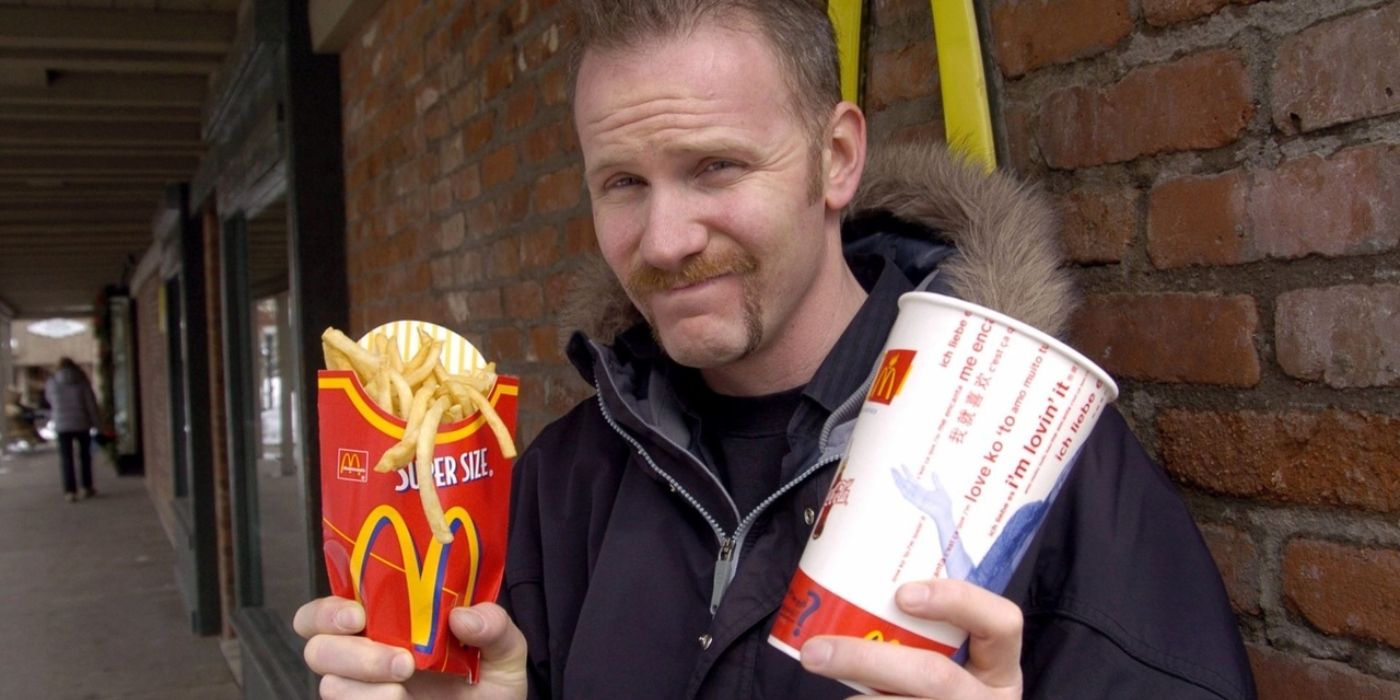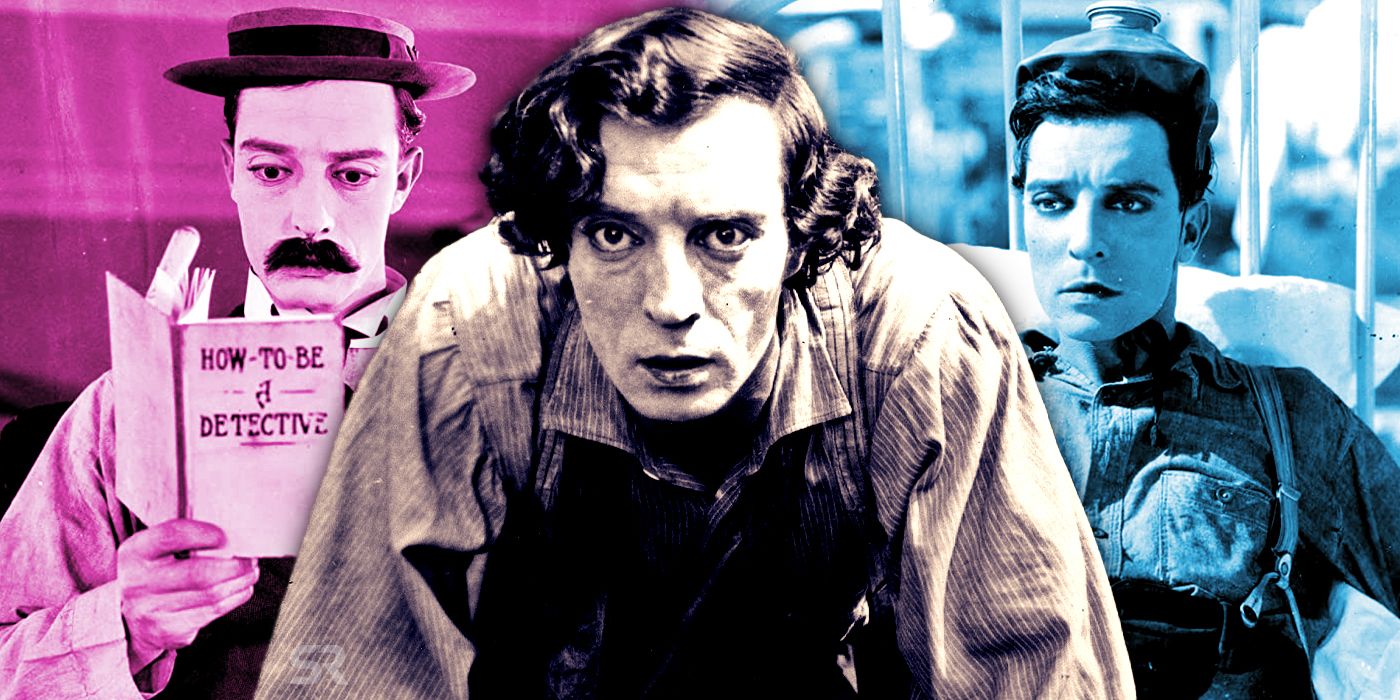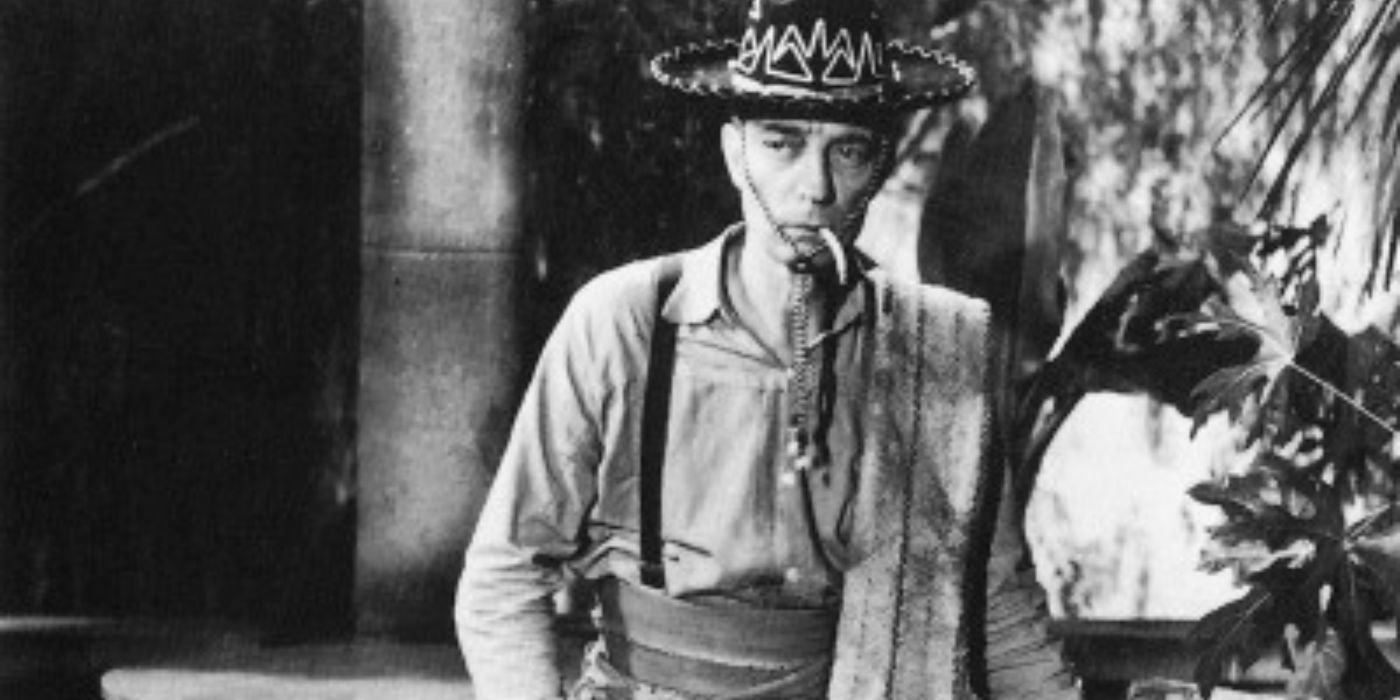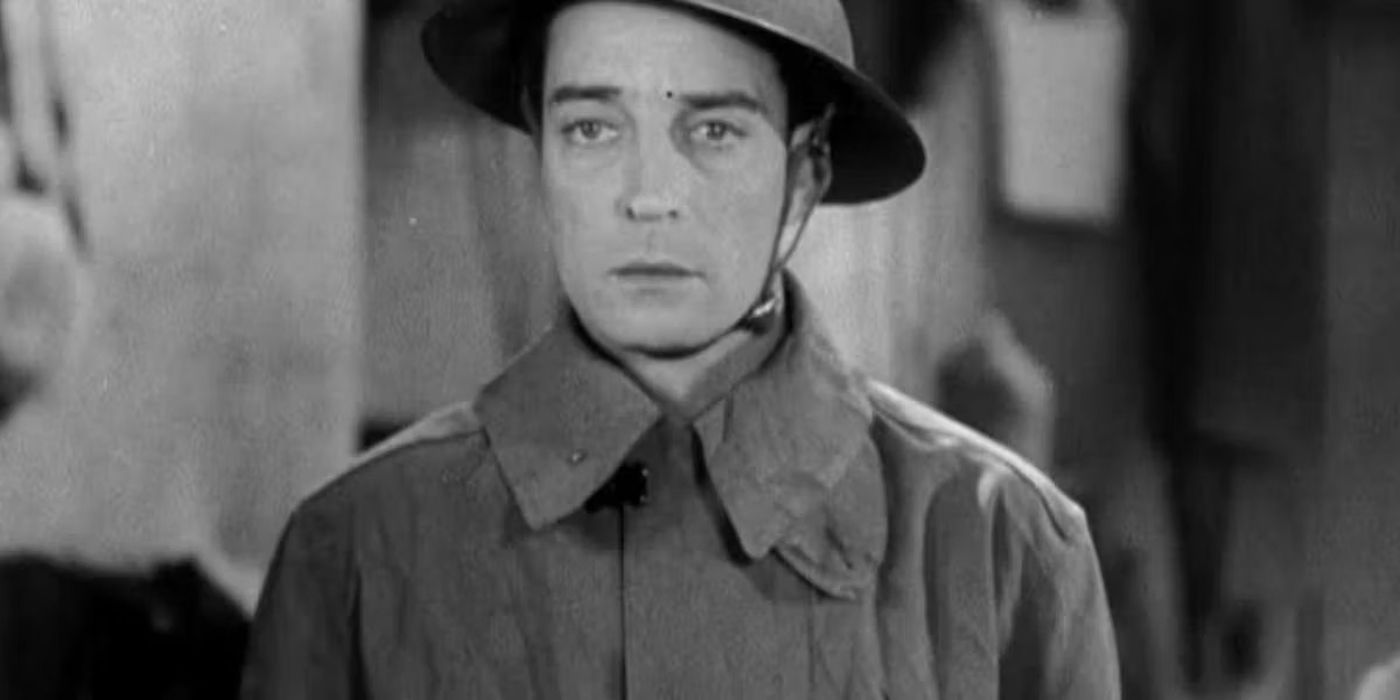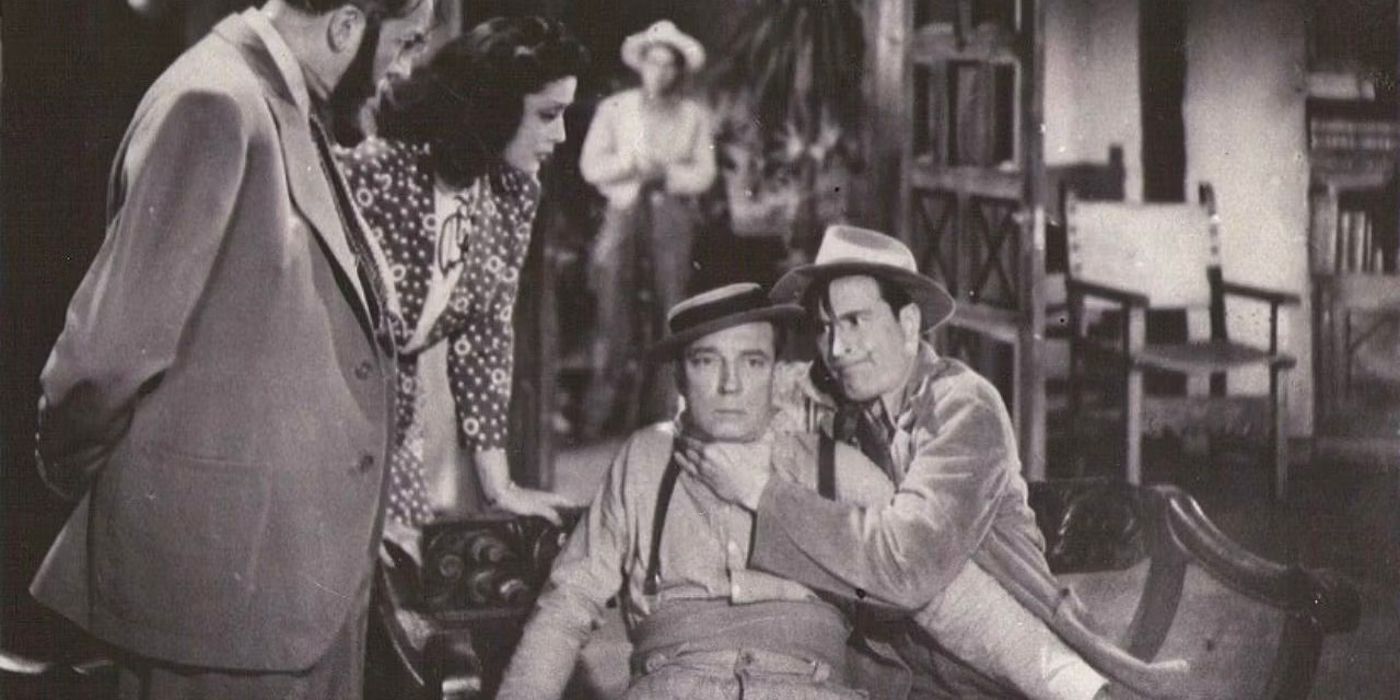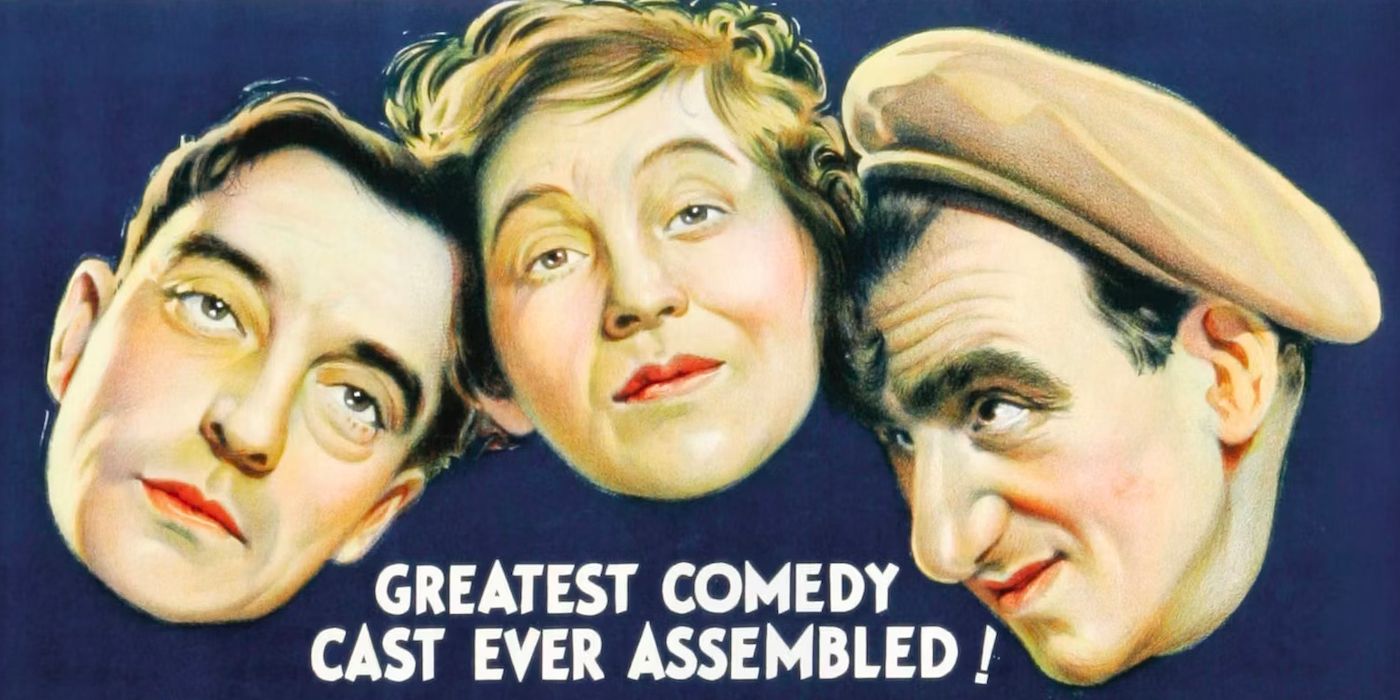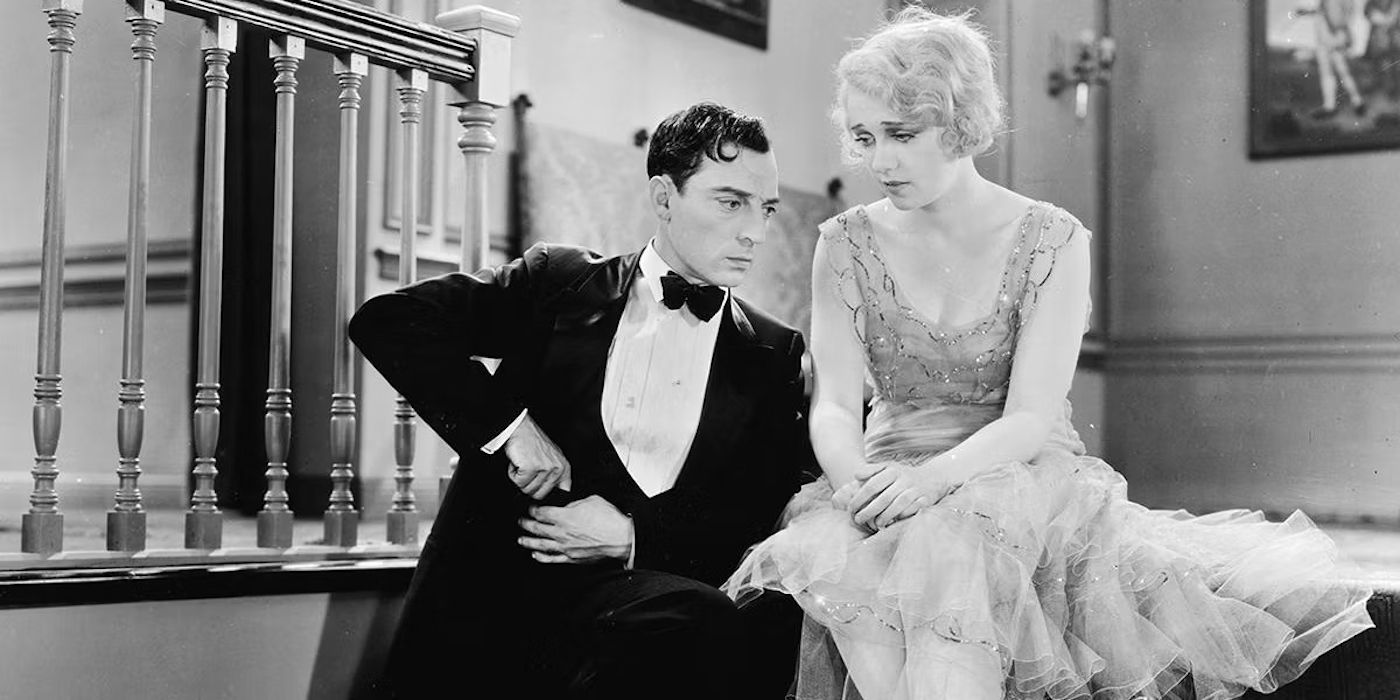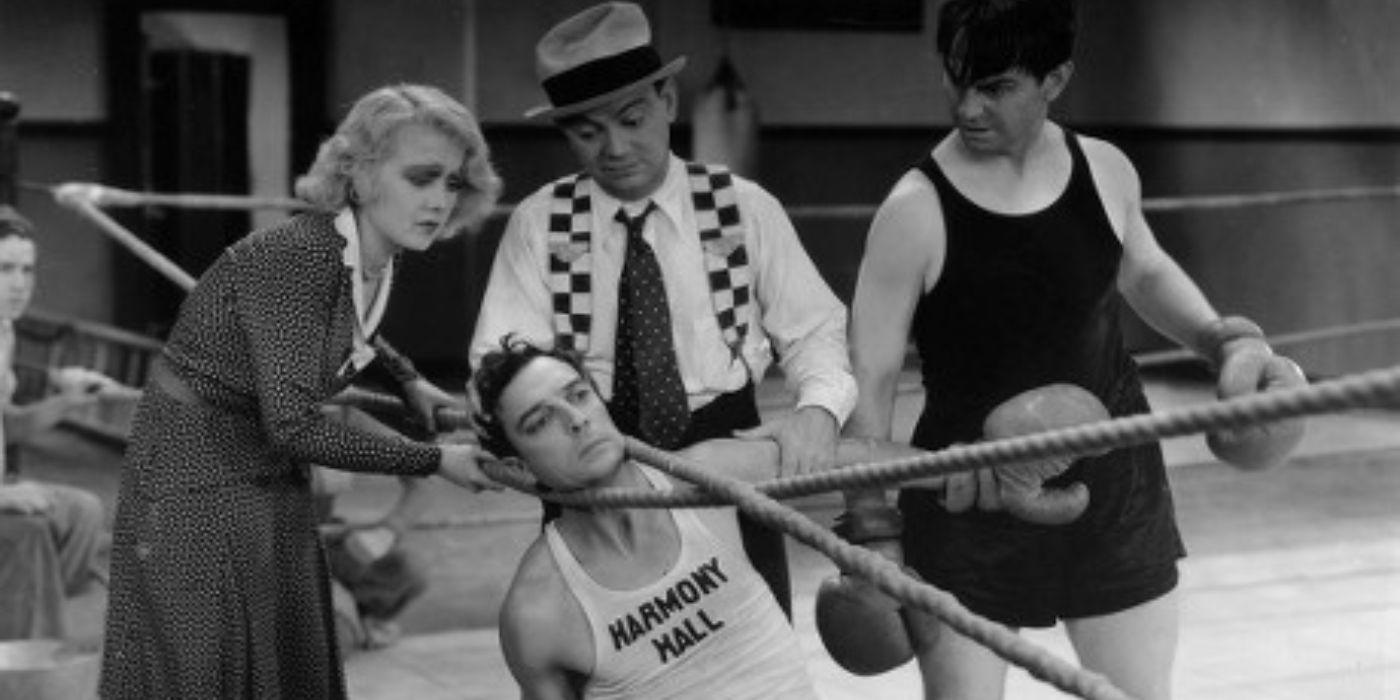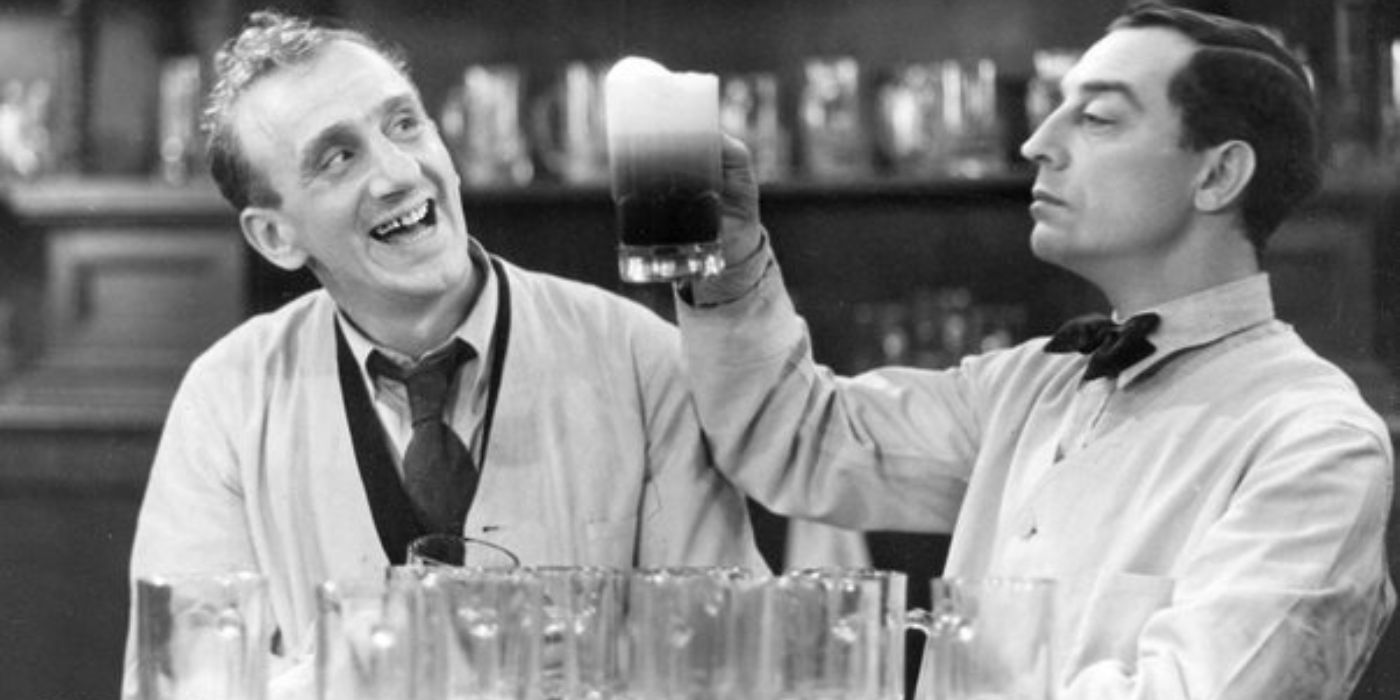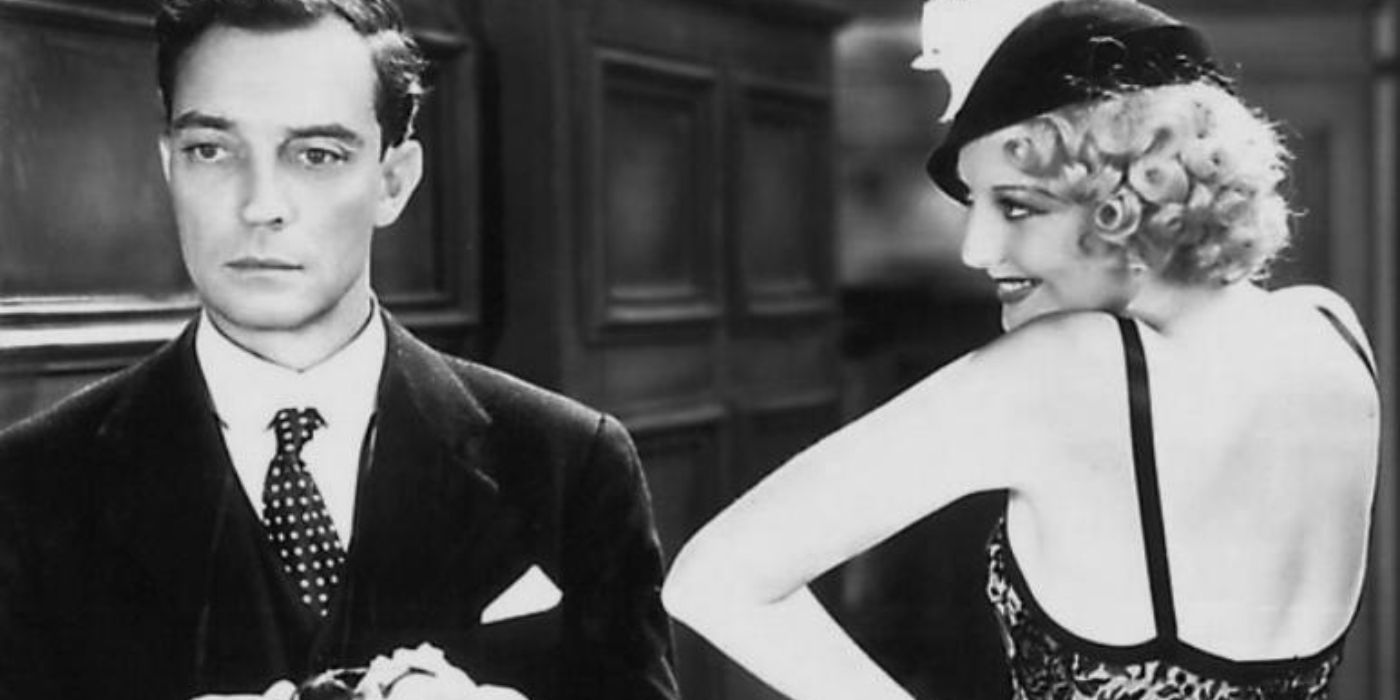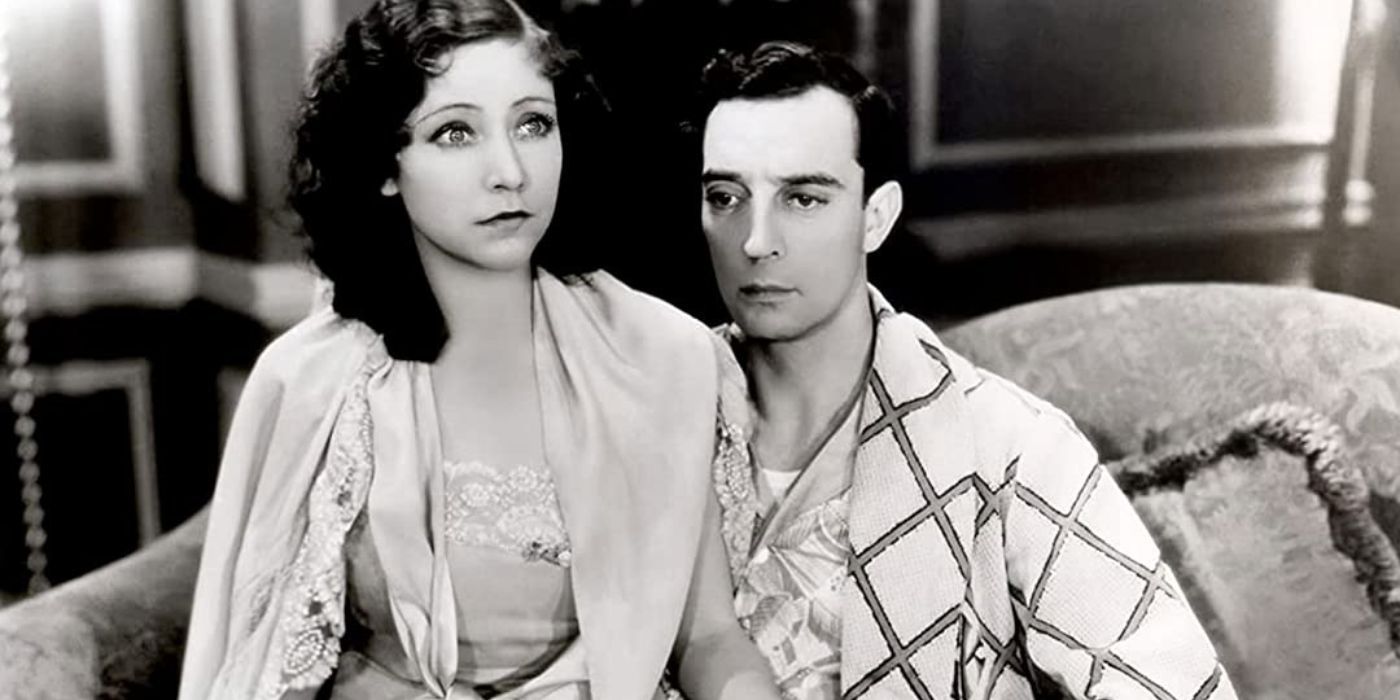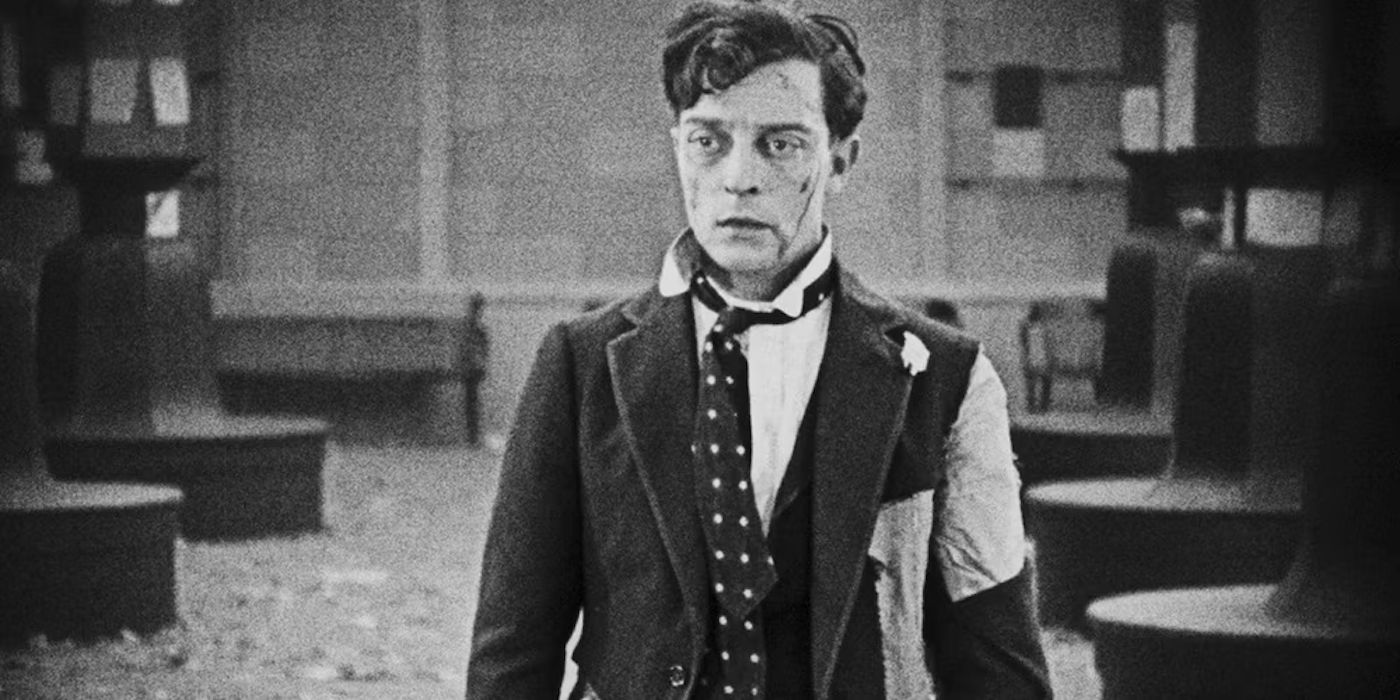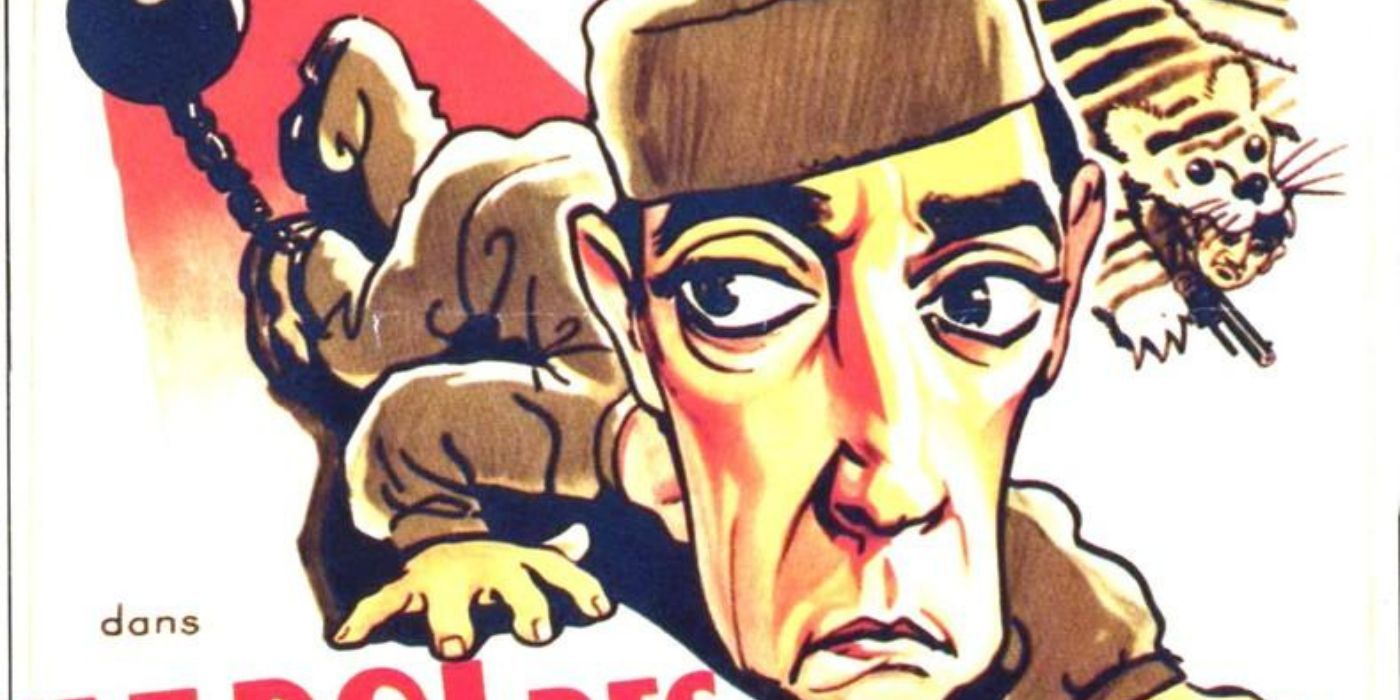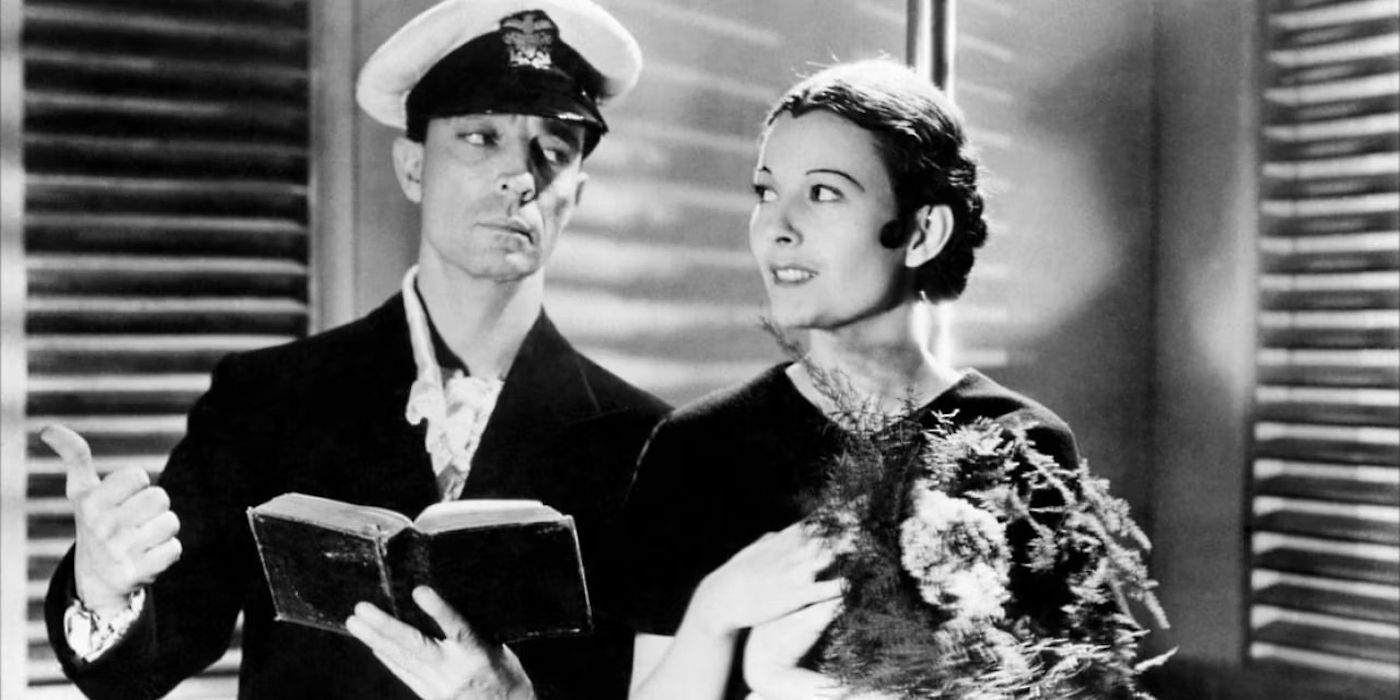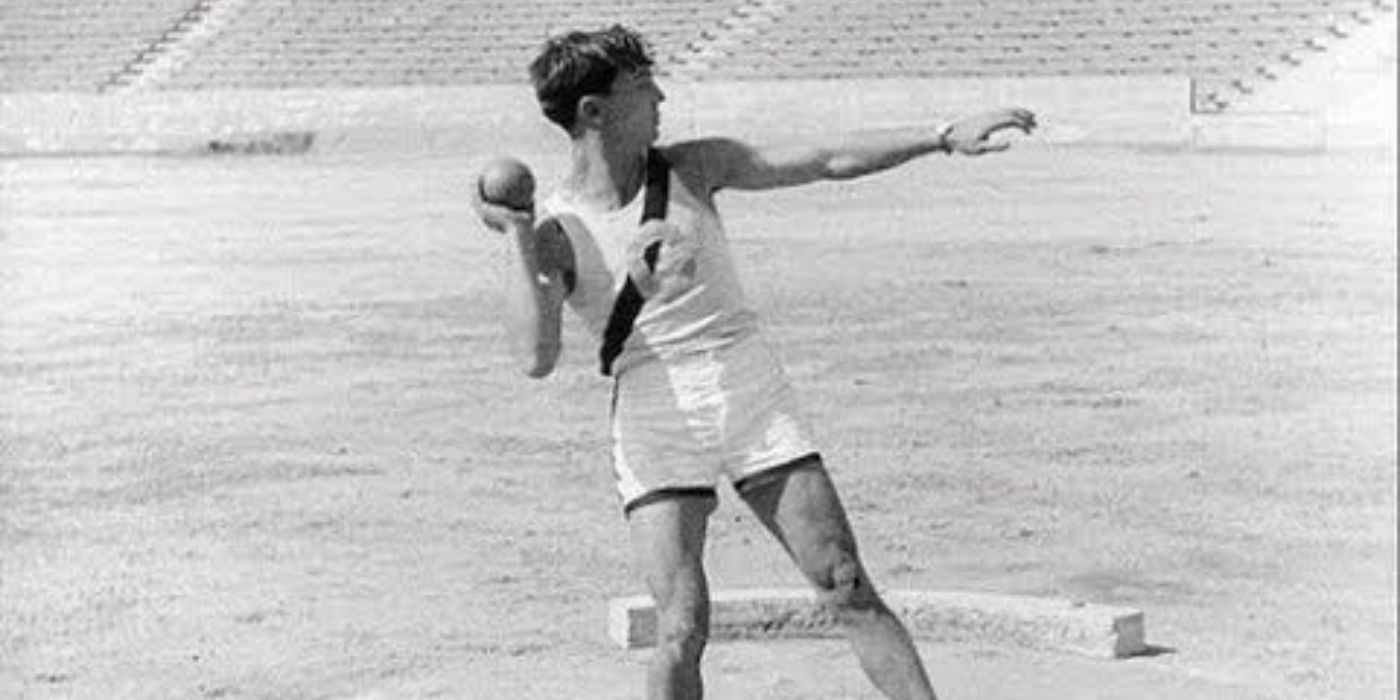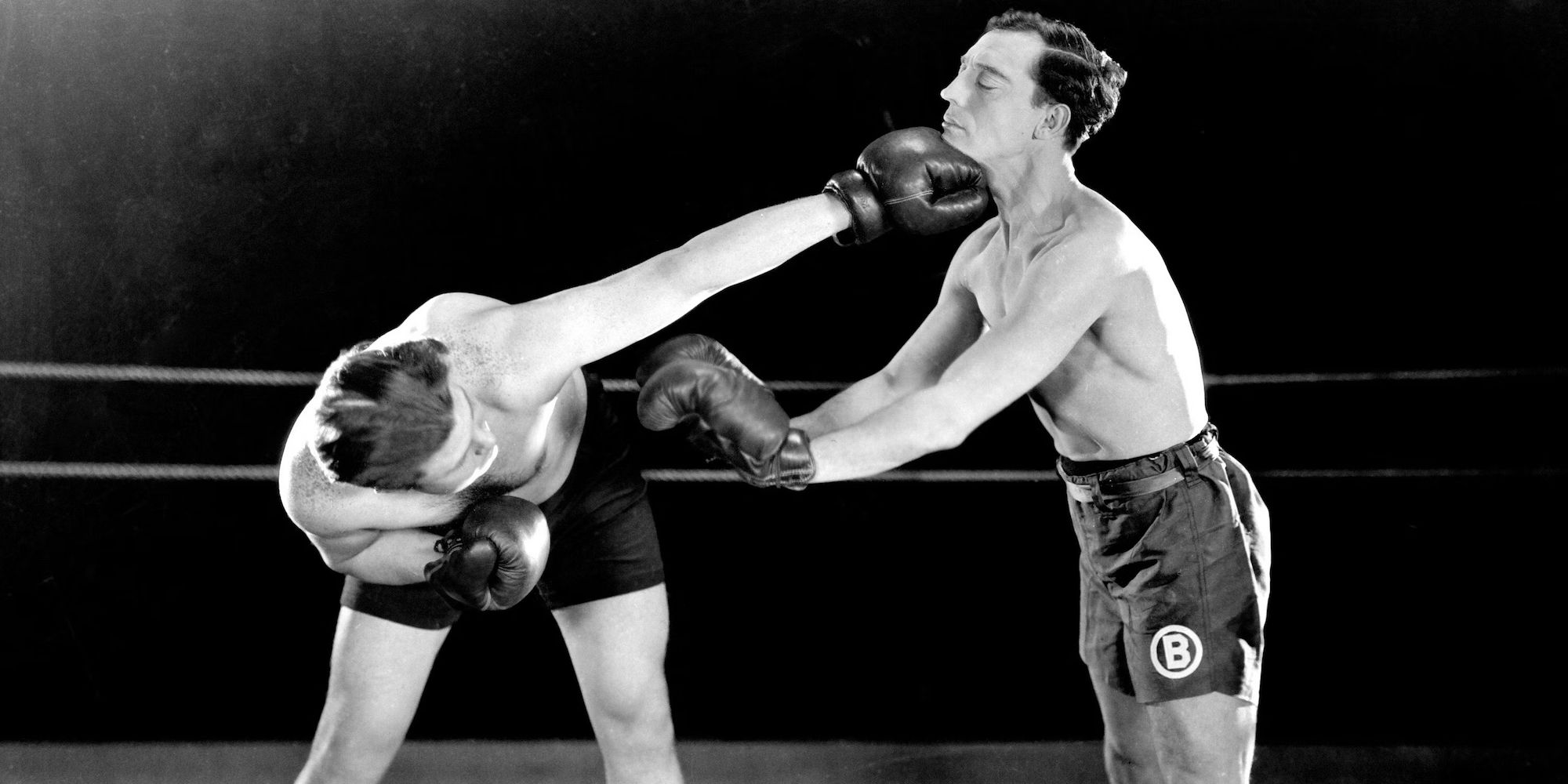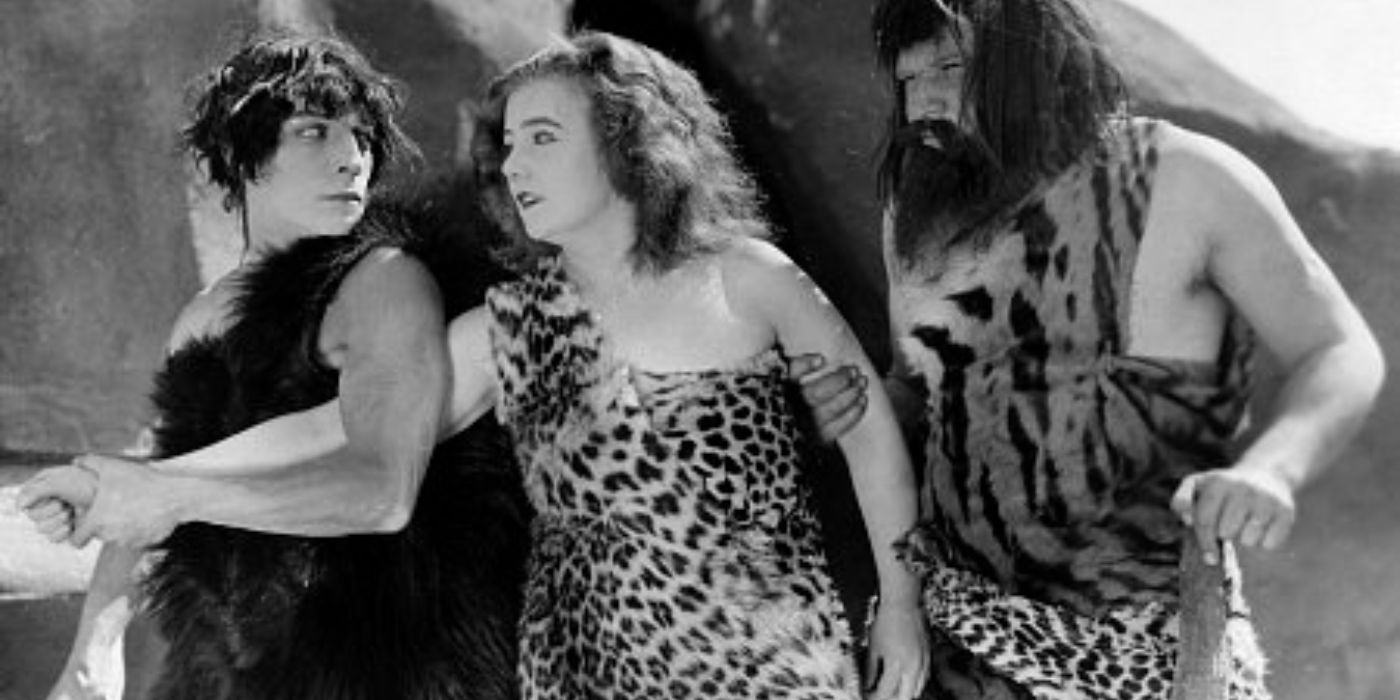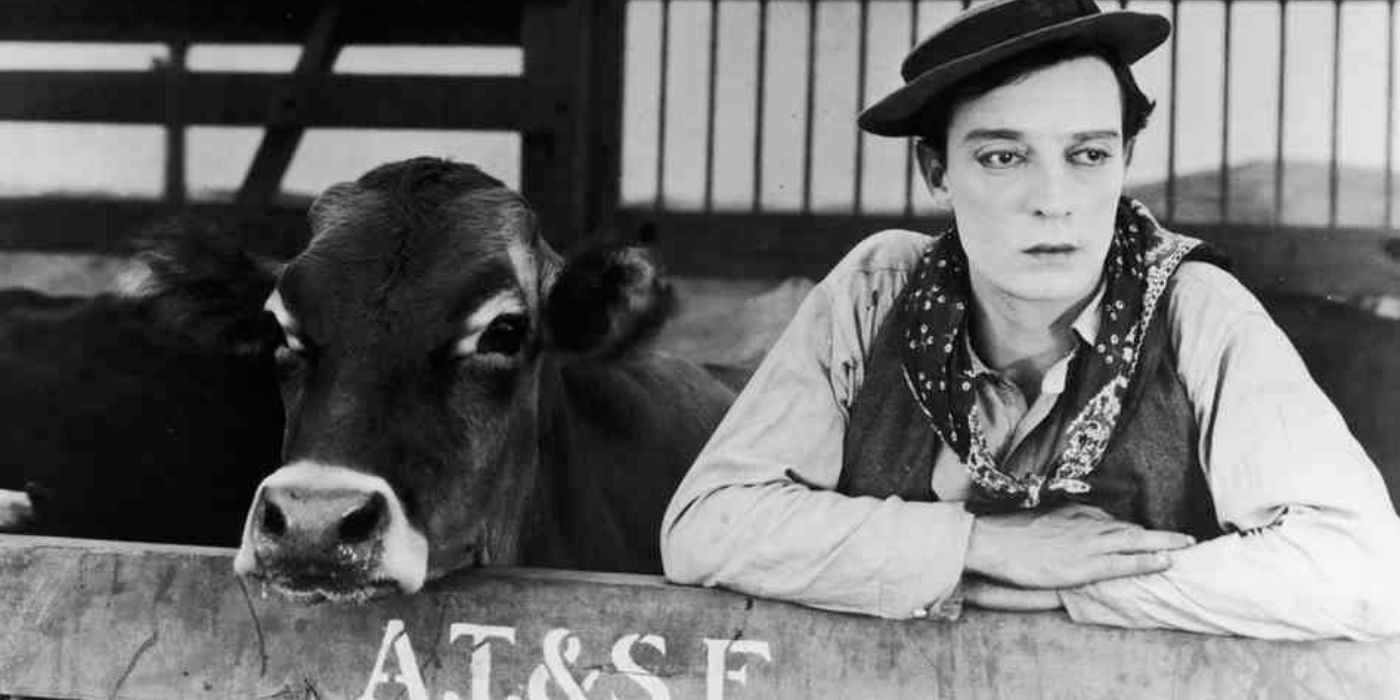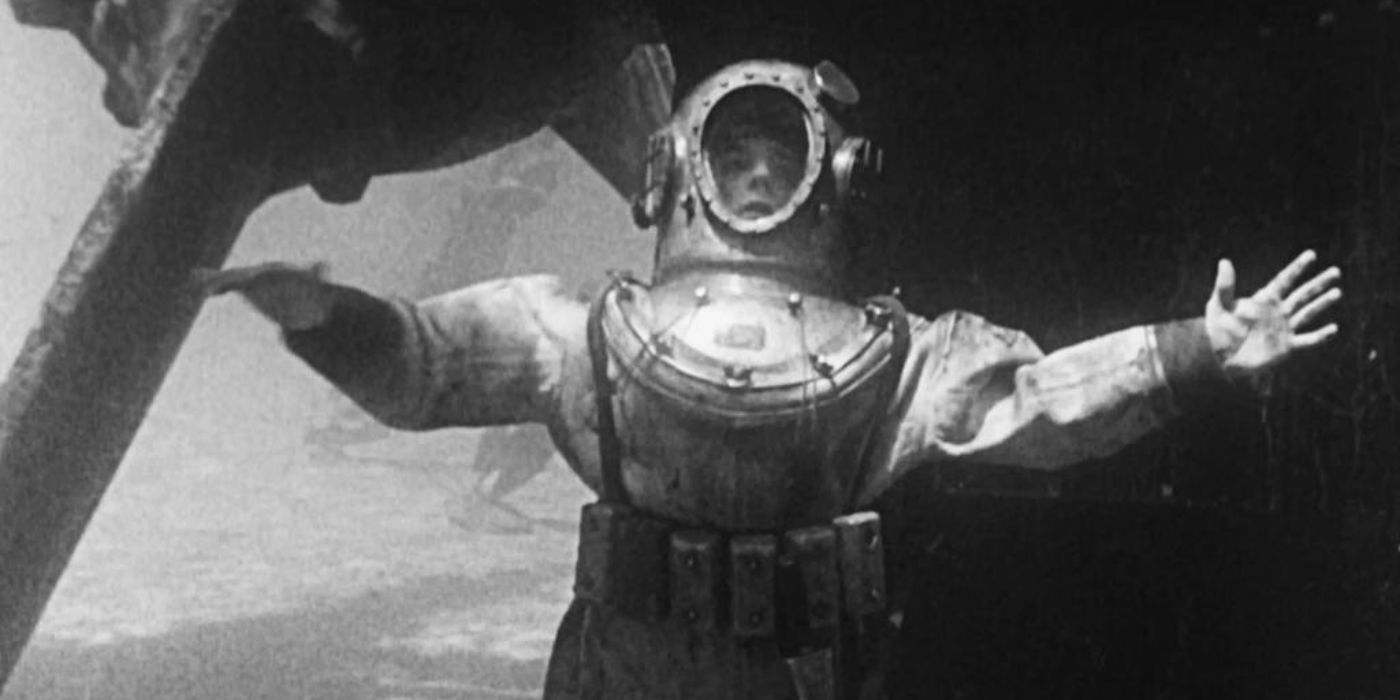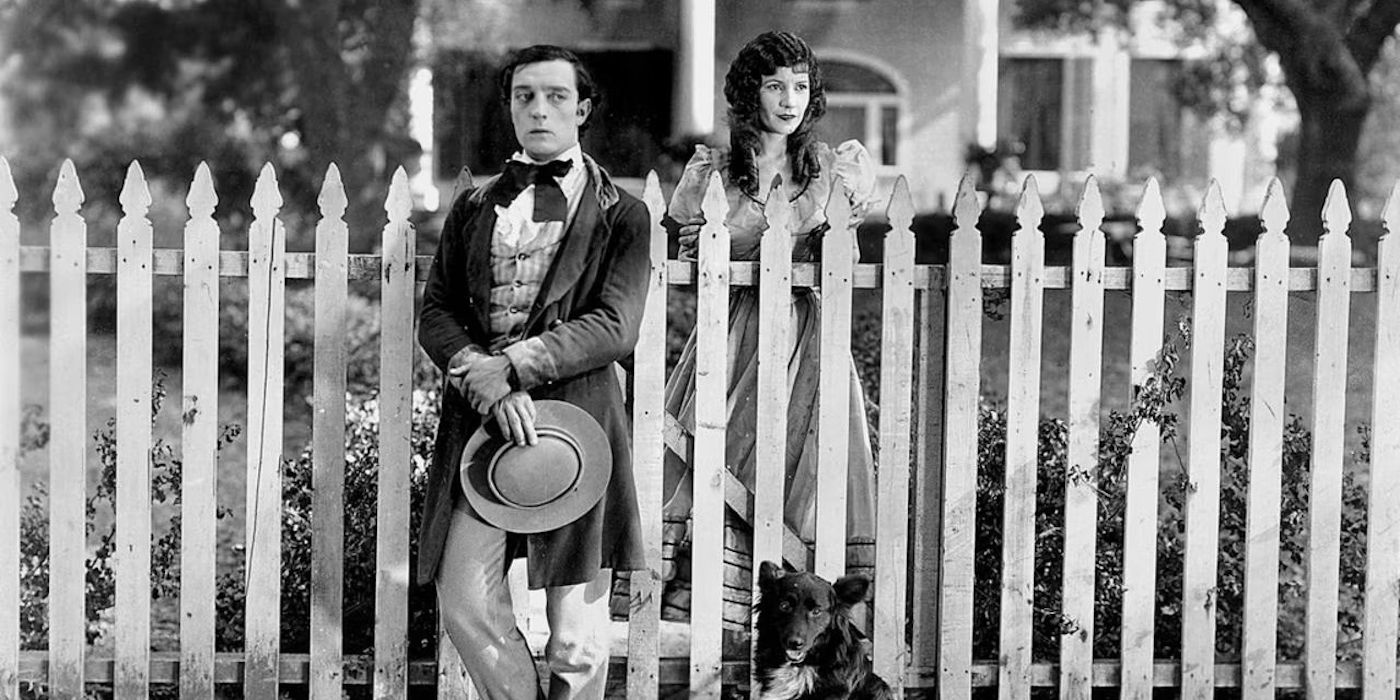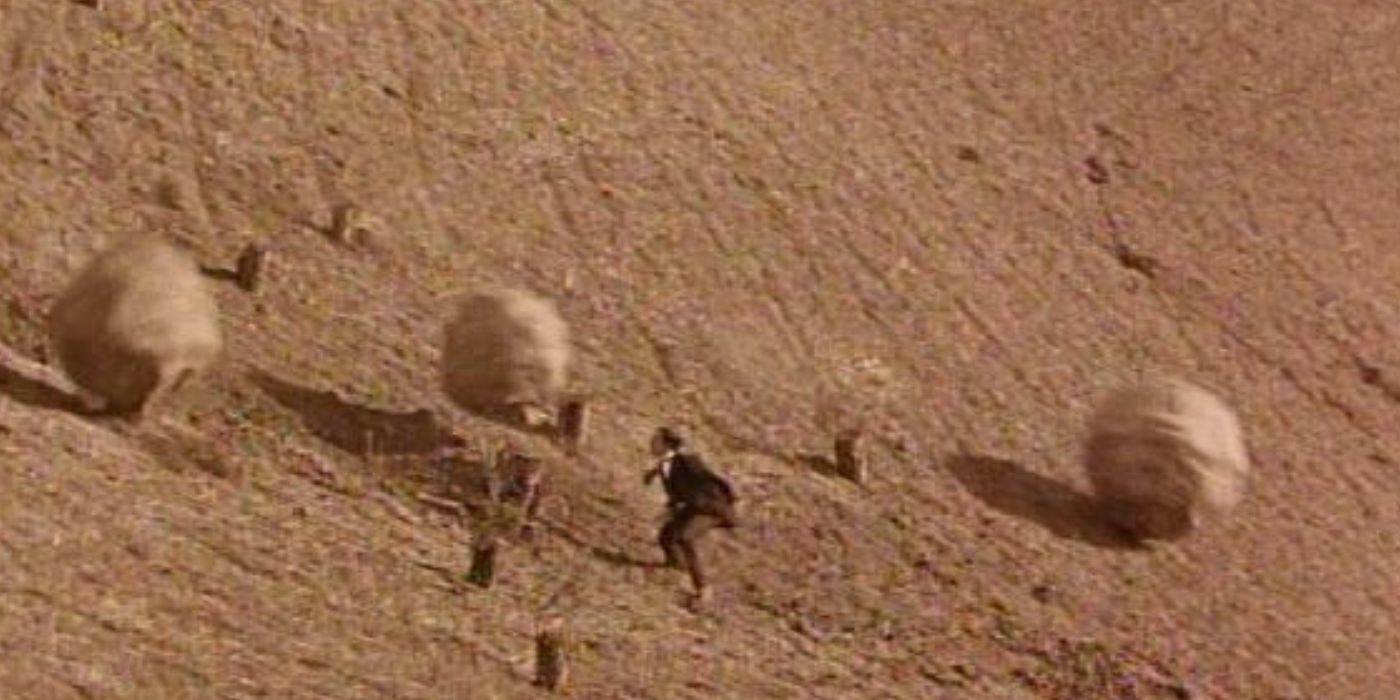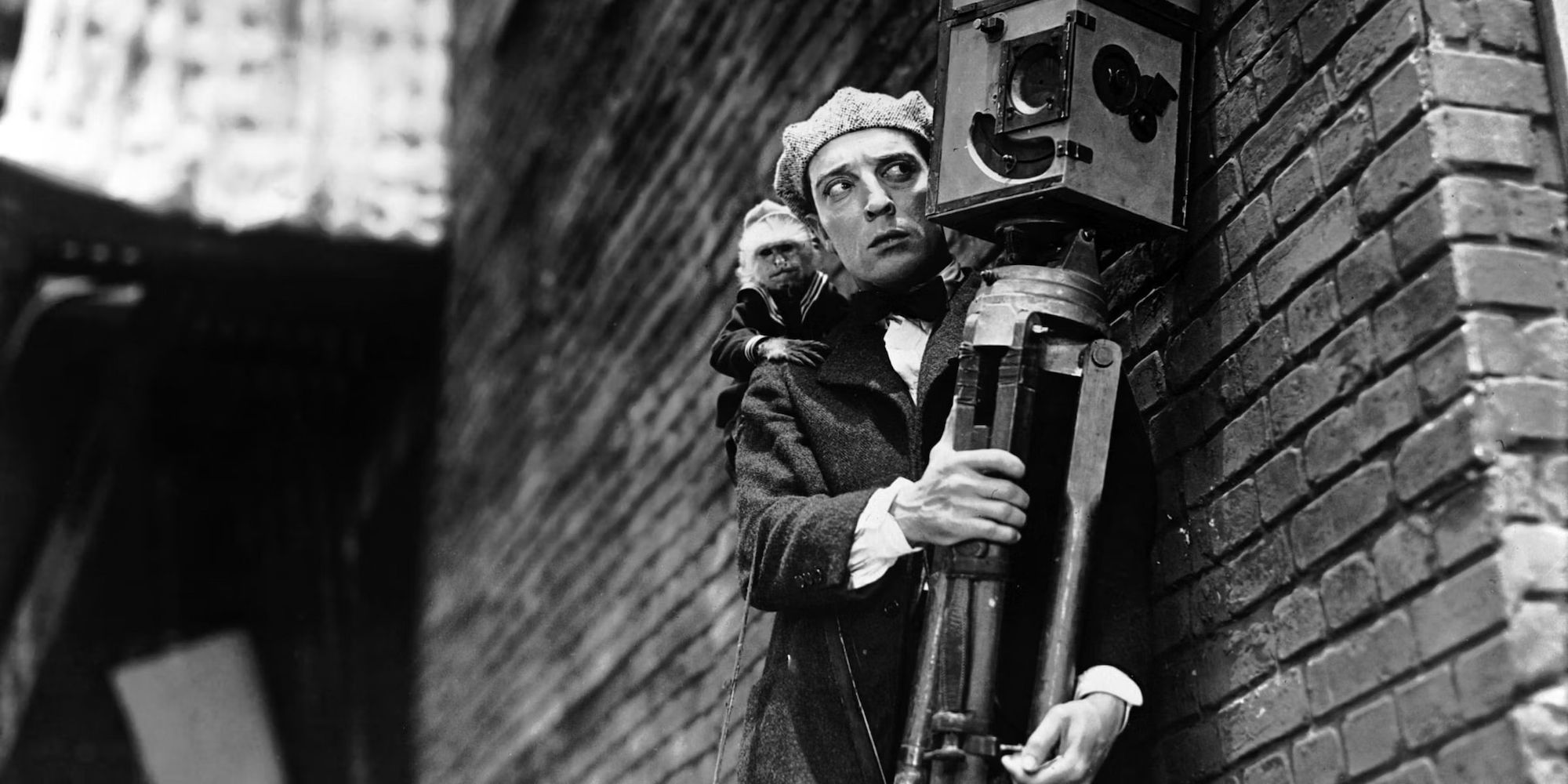From Sherlock Jr. to The General, the current decade will mark the 100th anniversary of several of Buster Keaton's movies. However, unlike other yesteryear stars, Keaton's filmography is somehow not dated. It has instead been influential to the history of cinema as a whole, particularly in the action and comedy genres. His collective work definitely makes him as significant as other silent comedy stars like Charlie Chaplin — with whom he finally shared the screen in the 1952 drama Limelight. Known for his deadpan facial expressions and exaggerated body language, Keaton and his work are worth revisiting for enthusiasts of silent cinema, physical comedy, and even stunt choreography.
To view Buster Keaton's movies in chronological order, cinephiles can start off with his features from the 1920s, a period considered to be the high point of his career. This was the era of silent film classics like Sherlock Jr., Three Ages, College, and many more. Most of the movies of this time were co-written and co-directed by Keaton as well. The second period in his feature film career can be marked by his late '20s and early '30s productions for MGM, a studio that limited his creative liberty. Excluding his short films and cameo roles, Buster Keaton has appeared in a total of 23 movies.
23 The Invader (1936)
A British movie acquired by MGM, The Invader found Buster Keaton playing Leander Proudfoot, a millionaire who aims to win the heart of a local woman in the South of Spain. The romantic comedy is wholesome but too simplistic and eventually got overshadowed by its much better remake, a 1939 short film also starring Keaton titled Pest from the West. The low production value doesn't let Keaton do much with the flimsy script either. With both Keaton and director Adrian Brunel at a creative low, The Invader has faded into obscurity compared to the rest of Keaton's MGM roster.
22 Doughboys (1930)
Director Edward Sedgwick oversaw most of Buster Keaton's MGM movies, Doughboys being one of them. As is common with Keaton's gags, he takes a shot at the idle class as he plays a rich man accidentally recruited into the military. Beyond a standard love triangle, Doughboys doesn't do more than deliver a few laughs. Even though it's set in the final years of World War I, the talkie's satirical look at wartime was not as fleshed out as what Charlie Chaplin set out to achieve a decade later with The Great Dictator. Regardless, Doughboys deserves a watch if viewers want a glimpse of Keaton in a relatively serious role.
21 Boom In The Moon (1946)
It's difficult to sum up the premise of Buster Keaton’s only Mexican production. Boom in the Moon starts off with Keaton's World War II survivor relocating to Mexico. After he is mistaken for a killer, he's blasted off to the Moon where more cases of mistaken identity, this time involving aliens, occur. The plot attempts to mix genre tropes of war drama and sci-fi while Keaton slightly tones down his humor. The sheer ambition is what makes it a slightly muddled-up watch. At the same time, Boom in the Moon is worth revisiting for viewers who need a slightly darker and unconventional entry in Keaton’s filmography.
20 The Passionate Plumber (1932)
A comedy of errors with a great ensemble, The Passionate Plumber stars Buster Keaton alongside fellow comedy icon Jimmy Durante and vaudeville legend Polly Moran. Keaton plays a Parisian plumber who is seeking financial aid for his new invention: a pistol with a range-finding light. When he somehow gets involved in an assassination attempt on a military leader, the pistol becomes a curse. However, for the 1930s movie audience, this provides one comic complication after another. The central trio's over-the-top theatrics wouldn't disappoint but with an undercooked story and unresolved plot holes, The Passionate Plumber still lags behind as an overall product.
19 Free And Easy (1930)
Buster Keaton's first leading role in a talkie found him in a meta-narrative as the MGM production revolved around Anita Page playing aspiring actress Elvira, who goes for a screen test at the very same movie studio. Posing as her manager and secretly falling for her, Keaton's Elmer perfectly evokes the shyness that his character requires. Given that this was his non-silent debut, however, the actor still had to polish his dialogue delivery before breaking out further in future talkies. Free and Easy also involved a familiar love triangle with Robert Montgomery appearing as a sleazy MGM studio executive, which by this time, felt cliché.
18 Sidewalks Of New York (1931)
The boxing movie genre provides ample space to explore comedic routines, especially for action-driven funny men like Buster Keaton. But with Keaton having made one of the best boxing comedies ever with Battling Butler in 1926, Sidewalks of New York proved to be another MGM production lacking the energy of his earlier self-produced features. Keaton plays a socialite who has a change of heart and trains street kids to become boxers instead of hoodlums. A boxing school opens, and hilarious duels ensue. Keaton is athletic as ever, but his frequent on-screen partner Anita Page outshines the rest of the cast playing an overprotective sister to one of the kids.
17 What-No Beer? (1933)
Regardless of the dwindling quality of some of the MGM features, the duo of Buster Keaton and Jimmy Durante were as dynamic as ever. What-No Beer? is a case in point with the two comedians playing men who cash in on the end of the Prohibition era. As Keaton and Durante implement their "million-dollar idea" of selling watered-down beer to a thirsty public, What-No Beer? not only makes for a delightfully entertaining watch but also doubles as a time capsule of the chaotic Prohibition years. Keaton's acting might not be top-notch here, but his acrobatic skills are marvelous in scenes where he's chased by the police.
16 Speak Easily (1932)
In Speak Easily, Buster Keaton plays a timid professor who falls so deeply in love with a dancer that he decides to finance her poorly written musical and take it all the way to Broadway. Thelma Todd is dashing as the performer while Jimmy Durante (now known for the Joker trailer song) delivers his usual wit as the manager of the dancing troupe. Exploring desperate attempts to produce a musical, Speak Easily succeeds at parodying showbiz and the eccentric people behind it. Relying on the same physical gags he'd incorporate in the Marx Brothers' A Night At The Opera, Keaton's performance is also as awkwardly brilliant as ever.
15 Parlor Bedroom And Bath (1931)
The third talkie of Buster Keaton's career found him playing the best of both worlds. While he's introduced as one of his typically socially awkward characters, he becomes a Casanova as he undergoes a My Fair Lady-like transformation. The duality of his character is hilariously exemplified by Keaton, who despite his straight-face expressions manages to put the speaking parts to good use in this lesser-known but unforgettable screwball classic. Before Parlor, Bedroom and Bath, filmgoers knew Keaton as an eccentric simpleton. Now, he stunned audiences by being a ladies' man. But just because he becomes charming and delivers heroic dialogues doesn't mean the movie has any shortage of goofiness either.
14 The Saphead (1920)
Buster Keaton got his first starring role in a feature with The Saphead. While it shows the deadpan comedy maestro in a nascent stage, his performance was singled out by critics upon its release. Keaton's stillness and hollow-eyed expressions made him an unconventional leading man, going in tandem with his character, a rich brat indulging in gambling and debauchery. The Saphead can be credited for building major interest in Keaton's subsequent work, leading to his more iconic silent movies. Interestingly, it was an adaptation of the stage play Henrietta, which starred silent-film legend Douglas Fairbanks. When it came to the screen version, Fairbanks suggested a young Keaton instead of himself.
13 Le Roi Des Champs-Élysées (1934)
The French-language comedy Le Roi Des Champs-Élysées is remembered as the movie where the stoic Buster Keaton finally smiled, but it suffered greatly from a shoddy dub for some of the speaking parts. Keaton appears in a double role as an aspiring actor and a convicted gangster, with a lot of the comedy stemming from the expected case of mistaken identity. The movie is surprisingly low on stunts even though Keaton does execute a few visually striking gags. For instance, when he gets a rough pat on the back, the drink in his hand is about to spill, yet he somehow gets every drop of it back in his glass!
12 Spite Marriage (1929)
To seek revenge on her faithless husband, a woman marries a naive tailor's assistant. As the latter doesn't realize that he's being used, hilarious gags and Buster Keaton's usual athleticism (which inspired Jackie Chan's comedy style) follow. Not just Keaton, but leading lady Dorothy Sebastian also falls into plenty of situations that demand her physical rigor. While the plot is not too different from the other movies of Keaton's career, Spite Marriage is of historic value given that it was his last silent film. Still, the synchronized score and the background laughter make it more immersive for a 1929 silent production and make the viewing experience all the more memorable.
11 College (1927)
Despite his physical prowess, Buster Keaton sinks his teeth into the character of an academically gifted but athletically challenged student in College. Doubling as a romantic comedy and a coming-of-age tale, it's a must-watch silent film to witness the originality of Keaton as a director. While good grades are fine, Keaton's character realizes he must dabble in a sport or two to stand out at school. To increase his social standing and impress the girl he fancies, he tries out every sport where he can — unintentionally — make a joke of himself. From track and field gags to rowing stunts, Keaton takes his brand of humor to new levels.
10 Battling Butler (1926)
Buster Keaton excels at poking fun at the rich. He can also deliver hilarious results when trying out sports. In Battling Butler, he does both as he plays a wealthy socialite posing as a famous boxer. While cases of mistaken identity might come off as recurring themes in Keaton's movies of the silent era, Battling Butler is surprisingly more heartwarming than humorous. In fact, a large consensus of Keaton's fans agrees that even though Battling Butler might not be the funniest of his comedies, it still boasts some of the most well-scripted storylines in his pantheon. A final face-off only goes on to add more dramatic depth.
9 Three Ages (1923)
While The Saphead was a success, Buster Keaton still had to prove his worth as a creative force in the world of feature films. His short films had already garnered acclaim, but Three Ages allowed him to explore the anthology format as he plays three men in three different historical ages. With each of the protagonists embarking on romantic misadventures, Three Ages proved to be a major step forward in Buster Keaton's biopic-worthy filmmaking career, and it is still well-received as the first-ever feature that he wrote, directed, produced, and starred in. The intercut segments act as effective parodies of the period drama and historical epic genres.
8 Go West (1925)
As a nameless drifter in Go West, Buster Keaton dares the Wild West by engaging in seemingly mundane activities and turning them into Herculean adventures complete with exaggerated mannerisms. From cattle wrangling to dairy farming to even befriending a cow, Keaton does it all. Even in the parts that don't seem that plot-driven, Go West is interesting enough when the hero just attempts to fit in the wilderness. The Western genre was otherwise dominated by hypermasculine figures, but with Go West, Keaton proved how even the formulaic Western can be interpreted with a light-hearted lens.
7 The Navigator (1924)
If the land didn't provide him enough space to play with, Buster Keaton took his eccentric behavior to the seas in The Navigator. Also sitting in the director's chair, Keaton relied on his frequent collaborator Fred Gabourie to handle the art direction. The result is that the titular ocean liner becomes a character on its own with Keaton utilizing every nook and corner for cutting-edge mechanical comedy. If this weren't enough, he even goes on to repair a ship in full diving suit gear. With the story basically dealing with a rich protagonist trapped in an empty passenger vessel, the movie's scale is definitely praiseworthy for 1920s Hollywood movie standards.
6 Our Hospitality (1923)
An obvious parody of the infamous feud between the American rural families the Hatfields and the McCoys, Our Hospitality blends Civil War-era drama with carefully edited slapstick comedy, rightfully making it a classic. At the time of its release, critics and audiences were in sheer awe of how a serious storyline could feature gag-reliant comedy at the right moments. While Buster Keaton seems comfortable with claustrophobic urban settings, Our Hospitality is grander in scale with extensive landscapes and period-accurate sets. His then-wife Natalie Talmadge and his father, Joe Keaton, have supporting roles, making it quite a family affair.
5 Seven Chances (1925)
In one of the laugh-out-loud funniest comedies of all time, a banker who is down on his luck gets a chance to inherit a fortune of $7 million. The catch is that he must get married by the end of his 27th birthday, an arduous time-bound task that leads to one of the most ambitious finales imaginable. One sequence in Seven Chances continues to be a favorite Buster Keaton stunt: as boulders chase the hero down a hill, the movie proves equally hilarious and thrilling. With many more hair-raising stunts captured without a double, Keaton proves his mettle as not just a comedic stalwart but also an action star.
4 The Cameraman (1928)
His deal with MGM was an overall disappointment, but Buster Keaton's debut for the studio is still regarded as his last great masterpiece, and it's also one of the best movies about baseball. The Cameraman is a romantic comedy that finds the title character hopelessly chasing an MGM employee while pursuing his creative dreams of becoming a successful newsreel photographer. The dual motives of romance and ambition fueling his actions make his character a well-rounded protagonist. The fast-paced action is top-notch, but behind all the belly laugh-inducing chases the movie is ultimately about a broken man searching for purpose, almost foreshadowing Keaton's own grim future in the years to follow.


